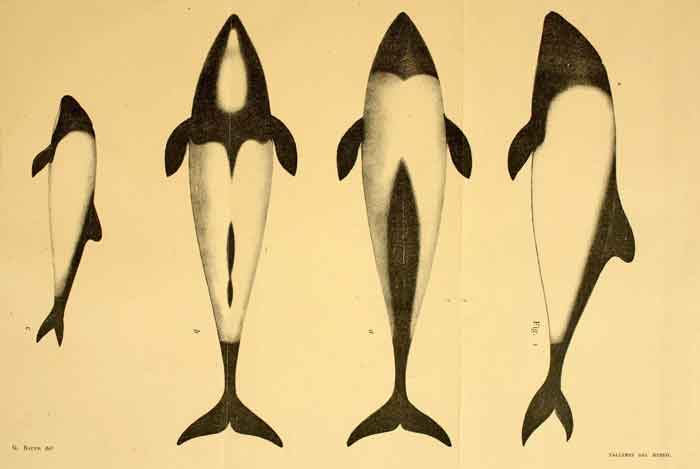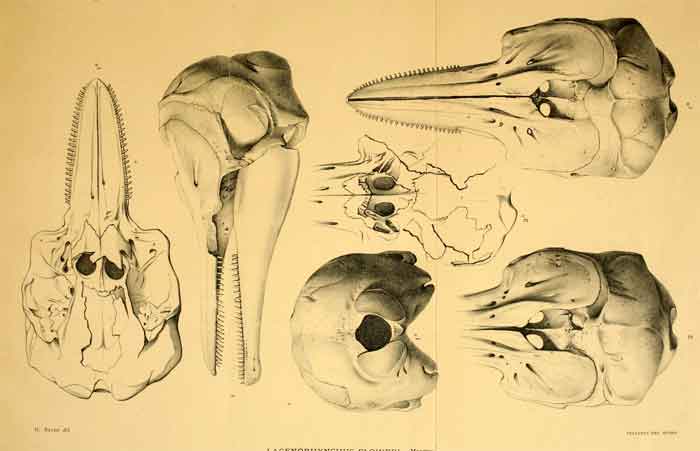
Cephalorhynchus commersonii, Photo: Michael Lahanas
Superregnum: Eukaryota
Regnum: Animalia
Subregnum: Eumetazoa
Cladus: Bilateria
Cladus: Nephrozoa
Superphylum: Deuterostomia
Phylum: Chordata
Subphylum: Vertebrata
Infraphylum: Gnathostomata
Superclassis: Tetrapoda
Cladus: Reptiliomorpha
Cladus: Amniota
Cladus: Synapsida
Cladus: Eupelycosauria
Cladus: Sphenacodontia
Cladus: Sphenacodontoidea
Cladus: Therapsida
Cladus: Theriodontia
Cladus: Cynodontia
Cladus: Mammaliaformes
Classis: Mammalia
Subclassis: Trechnotheria
Infraclassis: Zatheria
Supercohort: Theria
Cohort: Eutheria
Cohort: Placentalia
Cladus: Boreoeutheria
Superordo: Laurasiatheria
Ordo: Artiodactyla
Subordo: Whippomorpha
Infraordo: Cetacea
Cladus: Neoceti
Parvordo: Odontoceti
Cladus: Delphinida
Superfamilia: Delphinoidea
Familia: Delphinidae
Genus: Cephalorhynchus
Species: Cephalorhynchus commersonii
Subspecies: C. c. commersonii – C. c. kerguelensis
Name
Cephalorhynchus commersonii Lacépède, 1804
Etymology: commersonii for Philibert Commerson, who first described them in 1767 after sighting them in the Strait of Magellan.
Synonyms
Cephalorhynchus commersoni Yanez, 1948
Delphinus commersonii Lacépède, 1804
Lagenorhynchus burmeisteri Moreno, 1892
Lagenorhynchus floweri Moreno, 1892
Phocoena commersonii Lesson, 1827
References
Robineau, D., Goodall, R.N.P., Pichler, F. & Baker, C.S. 2007. Description of a new subspecies of Commerson's dolphin, Cephalorhynchus commersonii (Lacépède, 1804), inhabiting the coastal waters of the Kerguelen Islands. Mammalia 71: 172–180. ISSN (Online): 1864–1547, ISSN (Print): 0025–1461 DOI: 10.1515/MAMM.2007.034
Cephalorhynchus commersonii in Mammal Species of the World.
Wilson, Don E. & Reeder, DeeAnn M. (Editors) 2005. Mammal Species of the World – A Taxonomic and Geographic Reference. Third edition. ISBN 0-8018-8221-4.
Vernacular names
English: Commerson’s Dolphin
suomi: Kirjodelfiini
magyar: Commerson-delfin
日本語: イロワケイルカ
polski: delfin czarnogłowy
svenska: Commersons delfin, skäckig delfin
Türkçe: Alaca yunus

Commerson's dolphin (Cephalorhynchus commersonii), also referred to by the common names jacobita, skunk dolphin, piebald dolphin, panda dolphin, or tonina overa (in South America), is a small oceanic dolphin of the genus Cephalorhynchus. Commerson's dolphin has two geographically-isolated but locally-common subspecies. The principal subspecies, C.c.commersonii, has sharply-delineated black-and-white patterning and is found around the tip of South America. The secondary subspecies, C.c.kerguelenensis, is larger than C.c.commersonii, has a less-sharply delineated dark and light grey patterning with a white ventral band, and is found around the Kerguelen Islands in the Indian Ocean.
The dolphin is named after French naturalist Dr Philibert Commerson, who first described them in 1767 after sighting them in the Strait of Magellan.[4]

Population and distribution
Two disjunct subspecies of the dolphin are found in geographically disparate areas separated by 130° of longitude and about 8,500 km (5,300 mi); it is not known why they are thus distributed. Global populations are unknown, but the species is accepted to be locally common.
The main subspecies, C.c.commersonii, is found inshore in various inlets in Argentina including Puerto Deseado, in the Strait of Magellan and around Tierra del Fuego, and near the Falkland Islands (Las Malvinas). A survey in 1984 estimated there to be 3,200 individuals in the Strait of Magellan. [5]
Dolphins of the second subspecies, C.c.kerguelenensis, were discovered in the 1950s. They reside near the Kerguelen Islands in the southern part of the Indian Ocean, and prefer shallow waters.
In 2004, a vagrant individual of unconfirmed origin was sighted on South Africa's Agulhas Bank, a location 4,200 km (2,600 mi) from the Kerguelen Islands and 6,300 km (3,900 mi) from South America. Though the Kerguelen Islands are closer, such a journey would require swimming against the Antarctic Circumpolar Current.[6]
Description
C.c.commersonii
Commerson's dolphins in the Strait of Magellan
The commersonii subspecies has a black head, dorsal fin, and fluke, with a white throat and body. The demarcation between the two colours is very clear-cut. This stocky creature is one of the smallest of all cetaceans, growing to around 1.5 m (5 ft). A mature female caught off of southern Patagonia, at 23 kg (51 lb) and 1.36 m (4.5 ft), may be the smallest adult cetacean on record.[7] Its appearance resembles that of a porpoise, but its conspicuous behaviour is typical of a dolphin. The dorsal fin has a long, straight leading edge which ends in a curved tip. The trailing edge is typically concave, but not falcate. The fluke has a notch in the middle.
Sexes are easily distinguished by the different shape of the black blotch on the belly — it is shaped like a teardrop in males but is more rounded in females. Females reach breeding age at six to 9 years. Males reach sexual maturity at about the same age. Mating occurs in the spring and summer and calving occurs after a gestation period of 11 months during the spring and summer.[8] The Commerson's dolphin has been known to live up to eighteen years in the wild, while in captivity the oldest individual was at least 33 years old at the time of death.[9]
C.c.kerguelenensis
Dolphins of the kerguelenensis subspecies tend to be larger than those of C.c.commersonii, and differ in patterning in that they are dark grey instead of black, and light grey instead of white, except ventrally. The demarcation between areas of the pattern is also less clearly demarcated.[10]
Behavior
Commerson's dolphin is very active. It is often seen swimming rapidly on the surface and leaping from the water. It also spins and twists as it swims and may surf on breaking waves when very close to the shore. It will bow-ride and swim behind fast-moving boats. It is also known to swim upside-down, which is thought to improve the visibility of its prey.
This dolphin feeds on a mix of coastal and pelagic fish and squid. Those in the South American subpopulation supplement their diets with crustaceans. Individuals have been recorded as entering the Santa Cruz River to forage there during low tide.[11]
Conservation
The IUCN lists Commerson's dolphin as Least Concern in its Red List of Threatened Species. The proximity of the dolphin to the shore makes accidental killing in gillnets a common occurrence. The dolphin was killed for use as crab bait by some Argentinian and Chilean fishermen in the 1970s and 1980s, but this practice has since been curtailed.[2]
The Commerson's dolphin population of South America is listed on Appendix II[12] of the Convention on the Conservation of Migratory Species of Wild Animals (CMS). It is listed on Appendix II[12] as it has an unfavourable conservation status or would benefit significantly from international co-operation organised by tailored agreements.[13]
Captivity
These dolphins have been known to be displayed in a few aquariums.[14][15]
See also
Cetaceans portal iconMammals portal Marine life portal
List of cetaceans
References
Wikimedia Commons has media related to Cephalorhynchus commersonii.
Wikispecies has information related to Cephalorhynchus commersonii.
Mead, J.G.; Brownell, R. L. Jr. (2005). "Order Cetacea". In Wilson, D.E.; Reeder, D.M (eds.). Mammal Species of the World: A Taxonomic and Geographic Reference (3rd ed.). Johns Hopkins University Press. pp. 723–743. ISBN 978-0-8018-8221-0. OCLC 62265494.
Crespo, E., Olavarria, C., Dellabianca, N., Iñíguez, M., Ridoux, V. & Reeves, R. 2017. Cephalorhynchus commersonii (errata version published in 2018). The IUCN Red List of Threatened Species 2017: e.T4159A128963283. Downloaded on 30 December 2018.
"Appendices | CITES". cites.org. Retrieved 14 January 2022.
Sharks and Whales (Carwardine et al. 2002), p. 370.
Leatherwood, S.; Kastelein, R. A.; Hammond, P. S. (1988). "Estimate of number of Commerson's dolphins in a portion of the northeastern Strait of Magellan, January-February 1984". Reports of the International Whaling Commission. 9: 93–102.
Bruyn, P. J. N., de; Hofmeyr, G. J. G.; Villiers, M. S., de (2006). "First record of a vagrant Commerson's dolphin, Cephalorhynchus commersonii, at the southern African continental shelf" (PDF). African Zoology. 41 (1).
Wood, The Guinness Book of Animal Facts and Feats. Sterling Pub Co Inc. (1983), ISBN 978-0-85112-235-9
F. Righi, Carina; S. Blanco, Gabriela; Esteban, Frere (2013). "Abundance and Spatial Distribution of Commerson's Dolphin (Cephalorhynchus commersonii)". Aquatic Mammals. 39 (1): 1–9. doi:10.1578/AM.39.1.2013.1. Retrieved 11 December 2018.
Pedicini, Sandra (1 February 2016). "Unusual Commerson's dolphins' time at SeaWorld's Aquatica coming to a close". Orlando Sentinel.
Jefferson, Thomas A.; Webber, Marc A. J. G. M.; Pitman, Robert L. (2008). Marine mammals of the world : a comprehensive guide to their identification (1st ed.). London: Academic. p. 263. ISBN 978-0-12-383853-7. Retrieved 8 December 2015.
Loizaga de Castro, Rocio; Dans, Silvana Laura; Coscarella, Mariano Alberto; Crepso, Enrique Alberto (2013). "Living in an estuary: Commerson´s dolphin (Cephalorhynchus commersonii (Lacépède, 1804)), habitat use and behavioural pattern". Latin American Journal of Aquatic Research. 41 (5): 985–991. doi:10.3856/vol41-issue5-fulltext-17. Retrieved 11 December 2018.
"Appendix II Archived 11 June 2011 at the Wayback Machine" of the Convention on the Conservation of Migratory Species of Wild Animals (CMS). As amended by the Conference of the Parties in 1985, 1988, 1991, 1994, 1997, 1999, 2002, 2005 and 2008. Effective: 5 March 2009.
"Convention on Migratory Species page on the Commerson's dolphin". Archived from the original on 3 March 2016. Retrieved 31 August 2011.
Batt, Elizabeth. "CAPTIVE COMMERSON'S DOLPHINS IN NORTH AMERICA". The Dolphin Project. Retrieved 11 December 2018.
Gewalt, Wolfgang (1990). "The Jacobita, or Commerson's dolphin (Cephalorhynchus commersonii)". Aquatic Mammals. 16 (2): 53–64.
National Audubon Society: Guide to Marine Mammals of the World ISBN 0-375-41141-0
Encyclopedia of Marine Mammals ISBN 0-12-551340-2
The Sierra Club Handbook of Whales and Dolphins
Retrieved from "http://en.wikipedia.org/"
All text is available under the terms of the GNU Free Documentation License

